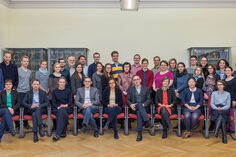Neural mechanisms of “smartphone addiction”
Cognitive neuropsychiarty section
Staff
Dr. med Gudrun M. Henemann
Dr. Mike Michael Schmitgen
Dr. med. Nadine Wolf
Prof. Dr. med. Robert Christian Wolf
Collaboration partners
Experimental child and adolescent psychiatry
Department of Neuroradiology, Heidelberg University Hospital
Currently no third-party funding.
DESCRIPTION
Popularity and availability of smartphones have dramatically increased in the past years. This trend is accompanied by increased concerns regarding potentially adverse effects of excessive smartphone use, particularly with respect to physical and mental health. Recently, the term “smartphone addiction” (SPA) has been introduced to describe smartphone-related addictive behavior and associated physical and psychosocial impairment. There are also ongoing concerns that excessive smartphone use may also have a negative impact on interpersonal relationships, eventually leading to worries and fears of missing events of importance (“Fear of Missing Out”).
In our first studies on excessive smartphone use (sometimes also referred to as “smartphone addiction”), we could detect differences in brain structure and function between excessive smartphone users and non-excessive users via MRI-scans (https://pubmed.ncbi.nlm.nih.gov/32062336/ , https://pubmed.ncbi.nlm.nih.gov/32403056/). The patterns of structural and functional change showed a remarkable spatial similarity with neural signatures of addictive behavior, as detected e.g. in Internet Gaming Disorder, but also in several substance-use-disorders
In this study, we want to extend our previous findings in terms of effects of 72 h abstinence of smartphone use. In analogy to other substance-related or behavioral addictions, abruptly renouncing smartphone use may lead to different degrees of craving. The major aim of this study is to examine, if – even short-term – smartphone abstinence could lead to changes in brain activity. Such changes may occur when the brain is not involved in active stimulus processing (i.e. during the brain’s “resting-state”), but also during specific conditions that are closely related to reactions to salient cues (i.e. smartphones) or in situations, where “Fear of Missing Out” comes into play.



